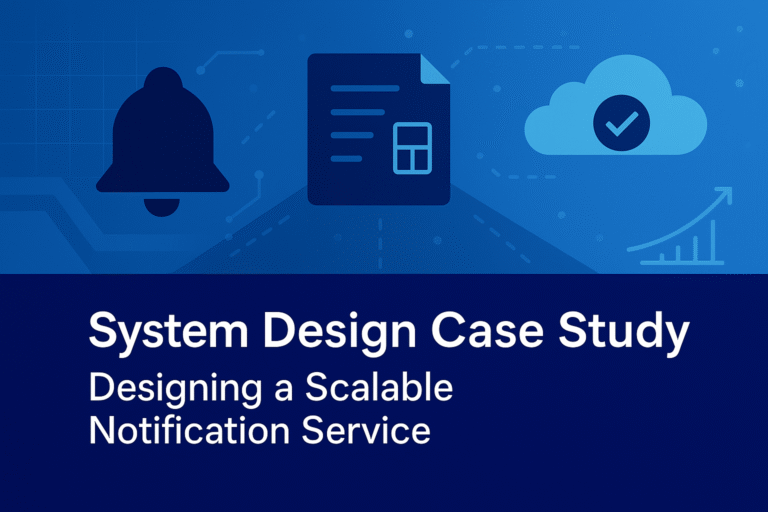Introduction
System design interviews are a pivotal component of the hiring process for software architect and senior engineering roles, testing a candidate’s ability to architect scalable, reliable, and efficient systems under complex constraints. Unlike coding interviews, which focus on algorithmic precision, system design interviews evaluate a broader skill set: the ability to translate ambiguous requirements into robust architectures, make informed trade-offs, and communicate solutions effectively. Over my 20+ years of designing distributed systems and mentoring candidates, I’ve observed that interviewers assess responses based on specific criteria—clarity, trade-off analysis, scalability considerations, depth of knowledge, and collaboration skills. This article delves into these evaluation criteria, offering insights into what interviewers look for and how candidates can excel in system design interviews. By understanding these expectations, aspiring architects can approach interviews with confidence and precision.
The Role of System Design Interviews
System design interviews simulate the real-world responsibilities of a software architect, who must design systems that meet functional and non-functional requirements while balancing constraints like cost, performance, and maintainability. Typical questions involve designing systems like a URL shortener, a social media news feed, or a distributed job scheduler, or optimizing existing architectures for scale. These scenarios test a candidate’s ability to think holistically, anticipate challenges, and propose solutions that align with business goals.
Interviewers use system design questions to evaluate a candidate’s readiness for senior roles, where strategic decision-making and cross-team collaboration are critical. My experience debugging production outages in high-traffic systems taught me that effective designs anticipate failure modes and scale gracefully—qualities interviewers seek in candidates. Understanding the evaluation criteria allows candidates to structure their responses to meet these expectations, demonstrating both technical expertise and leadership potential.
Key Evaluation Criteria
Interviewers assess system design answers based on several core criteria. Each criterion reflects a facet of architectural problem-solving, and excelling in these areas can distinguish a candidate in a competitive interview process.
1. Clarity of Thought and Communication
What Interviewers Look For: Interviewers prioritize candidates who can articulate their thought process clearly and structure their responses logically. System design problems are open-ended, often requiring candidates to present a solution on a whiteboard or virtual tool while explaining each component. Clarity in communication ensures that the interviewer understands the proposed architecture and the reasoning behind it.
How They Evaluate:
- Structured Approach: Does the candidate follow a clear framework, such as gathering requirements, proposing a high-level design, detailing components, and discussing trade-offs?
- Explanation Quality: Are complex concepts explained succinctly, avoiding jargon overload or ambiguity?
- Visual Representation: Does the candidate use diagrams effectively to illustrate the system’s architecture?
Example from Experience: Early in my career, I struggled to convey intricate designs during cross-team discussions, often diving into details too quickly. I learned to adopt a structured approach: start with a high-level overview, break down components, and then address specifics. In interviews, candidates should similarly begin by outlining the problem scope, sketching a high-level architecture, and then zooming into details like database selection or load balancing.
How to Excel:
- Start by restating the problem and asking clarifying questions (e.g., user scale, latency requirements).
- Use a framework like the “4Cs” (Clarify, Conceptualize, Componentize, Critique) to organize your response.
- Practice sketching clear diagrams, labeling components like frontend, backend, database, and cache.
- Explain your thought process aloud, ensuring the interviewer follows your reasoning.
2. Trade-Off Analysis
What Interviewers Look For: Every system design decision involves trade-offs, such as performance versus consistency or cost versus scalability. Interviewers assess whether candidates can identify these trade-offs, weigh their implications, and justify their choices with sound reasoning.
How They Evaluate:
- Identification of Trade-Offs: Does the candidate recognize trade-offs in their design (e.g., choosing a NoSQL database for scalability but sacrificing strong consistency)?
- Justification: Are choices backed by logical reasoning tied to the problem’s requirements?
- Adaptability: Can the candidate adjust their design when the interviewer introduces new constraints (e.g., budget limitations)?
Example from Experience: In a project to scale a real-time analytics platform, I initially prioritized low latency by implementing a distributed cache. However, this increased operational costs significantly. Reflecting on this, I realized that discussing cost-performance trade-offs upfront would have led to a more balanced design. In interviews, candidates must similarly articulate why they chose, for example, Redis over a relational database, citing factors like latency needs versus data consistency requirements.
How to Excel:
- For each design decision, explicitly state the trade-offs (e.g., “Using a NoSQL database improves write throughput but may require eventual consistency”).
- Tie trade-offs to the problem’s requirements (e.g., prioritizing low latency for a user-facing feature).
- Be prepared to adjust your design if the interviewer introduces constraints, such as reducing infrastructure costs.
3. Scalability Considerations
What Interviewers Look For: Scalability is a cornerstone of system design, as modern systems must handle increasing user loads or data volumes. Interviewers evaluate whether candidates can design systems that scale horizontally (adding more servers) or vertically (upgrading existing servers) and address potential bottlenecks.
How They Evaluate:
- Scalability Mechanisms: Does the candidate incorporate components like load balancers, caching layers, or database sharding to handle scale?
- Bottleneck Identification: Can the candidate identify and mitigate bottlenecks, such as database query latency or single points of failure?
- Future-Proofing: Does the design account for future growth, such as handling 10x traffic?
Example from Experience: Scaling a notification system taught me the importance of caching to reduce database load and sharding to distribute data. However, I learned the hard way that neglecting to monitor cache hit ratios led to performance degradation. In interviews, candidates should propose scalability solutions like horizontal scaling with load balancers and explain how they prevent bottlenecks, such as by using a CDN for static content.
How to Excel:
- Propose scalability solutions like load balancing, caching (e.g., Redis), and database sharding.
- Identify potential bottlenecks (e.g., single database server) and suggest mitigations (e.g., replication).
- Discuss how the system handles traffic spikes, such as using auto-scaling groups in cloud environments.
4. Depth of Technical Knowledge
What Interviewers Look For: Interviewers expect candidates to demonstrate a deep understanding of system design concepts, such as databases, networking, caching, and distributed systems. This includes knowing when to use specific technologies and understanding their underlying mechanics.
How They Evaluate:
- Component Selection: Does the candidate choose appropriate technologies (e.g., SQL vs NoSQL, REST vs gRPC) based on the problem’s requirements?
- Technical Details: Can the candidate explain how components work (e.g., how consistent hashing distributes data)?
- Edge Cases: Does the candidate address edge cases, such as network partitions or data consistency issues?
Example from Experience: In a project involving a distributed key-value store, I underestimated the impact of network latency on data consistency. Deepening my understanding of CAP Theorem and eventual consistency helped me design more robust systems. Interviewers similarly probe candidates’ knowledge by asking questions like, “Why choose Kafka over RabbitMQ for this use case?” or “How does a CDN reduce latency?”
How to Excel:
- Study core concepts like CAP Theorem, consistent hashing, and database indexing.
- Be prepared to explain why you chose specific technologies (e.g., “I chose Kafka for its high-throughput event streaming”).
- Address edge cases, such as handling network failures or ensuring data durability.
5. Collaboration and Adaptability
What Interviewers Look For: System design interviews are collaborative, requiring candidates to engage with the interviewer, respond to feedback, and adapt their designs. This mirrors the real-world role of an architect, who works with stakeholders to refine solutions.
How They Evaluate:
- Engagement: Does the candidate actively involve the interviewer by asking clarifying questions or seeking feedback?
- Adaptability: Can the candidate modify their design when the interviewer introduces new requirements or challenges?
- Team-Oriented Mindset: Does the candidate demonstrate a willingness to iterate based on input?
Example from Experience: During a cross-team project, I initially proposed a complex microservices architecture that ignored operational constraints raised by the DevOps team. Incorporating their feedback led to a simpler, more maintainable design. In interviews, candidates should similarly treat the interviewer as a collaborator, asking questions like, “Are there specific latency requirements?” and adapting their design based on responses.
How to Excel:
- Treat the interview as a discussion, not a monologue, by engaging the interviewer with questions.
- Be open to feedback and demonstrate flexibility by adjusting your design when prompted.
- Show a collaborative mindset by acknowledging alternative approaches and discussing their merits.
6. Handling Ambiguity
What Interviewers Look For: System design problems are often vague, requiring candidates to make assumptions and clarify requirements. Interviewers assess whether candidates can navigate ambiguity effectively and propose reasonable assumptions.
How They Evaluate:
- Requirement Clarification: Does the candidate ask questions to define the problem’s scope (e.g., user scale, data volume)?
- Reasonable Assumptions: Are assumptions practical and aligned with the problem context?
- Iterative Refinement: Can the candidate refine their design as requirements become clearer?
Example from Experience: A memorable lesson from my career was assuming a system needed to handle millions of users without clarifying the actual scale, leading to an over-engineered design. Asking questions upfront would have saved time and resources. In interviews, candidates should ask questions like, “What is the expected user base?” or “Are there specific availability requirements?” to avoid similar pitfalls.
How to Excel:
- Begin by asking clarifying questions to define the problem’s scope and constraints.
- State your assumptions explicitly (e.g., “I’m assuming 1 million daily active users”).
- Be prepared to adjust your design as the interviewer provides more details.
Common Pitfalls and How to Avoid Them
Based on my experience mentoring candidates, several common pitfalls can undermine system design responses. Here’s how to avoid them:
- Jumping into Details Too Quickly: Candidates often dive into low-level details (e.g., database schema) without outlining a high-level design. Solution: Start with a high-level architecture, then zoom into specifics.
- Ignoring Non-Functional Requirements: Focusing solely on functionality while neglecting scalability, reliability, or cost. Solution: Explicitly address non-functional requirements like latency and availability.
- Overcomplicating the Design: Proposing overly complex solutions that are hard to justify or maintain. Solution: Start with a simple, working design and iterate based on requirements.
- Poor Communication: Failing to explain the thought process or using excessive jargon. Solution: Practice explaining designs clearly, using diagrams and structured responses.
- Neglecting Trade-Offs: Choosing technologies without discussing alternatives or drawbacks. Solution: For every decision, articulate the pros, cons, and alternatives.
How to Prepare for System Design Interviews
To excel in system design interviews, candidates must combine theoretical knowledge, practical application, and communication skills. Here are actionable preparation strategies:
- Study Core Concepts: Master foundational topics like CAP Theorem, consistent hashing, database sharding, and load balancing. Resources like this book provide concise explanations to build your knowledge base.
- Practice Real-World Problems: Solve case studies like designing a URL shortener, YouTube, or a distributed rate limiter. Practice sketching architectures and explaining your reasoning.
- Learn from Industry Examples: Study architectures of systems like Netflix, Amazon, or Google to understand how concepts like CDNs, microservices, and fault tolerance are applied.
- Conduct Mock Interviews: Practice with peers or mentors to simulate the interview environment, focusing on structuring responses and handling feedback.
- Develop a Framework: Use a consistent framework for answering questions, such as:
- Clarify requirements and constraints.
- Propose a high-level architecture.
- Detail key components (e.g., database, cache, load balancer).
- Discuss trade-offs and scalability.
- Address edge cases and failure modes.
Conclusion
System design interviews are a critical evaluation of a candidate’s ability to architect robust, scalable systems while demonstrating clarity, trade-off analysis, and collaboration skills. Interviewers assess responses based on clarity of communication, depth of technical knowledge, scalability considerations, trade-off analysis, collaboration, and handling ambiguity. Drawing from my 20+ years of experience, I’ve seen how these skills translate directly to real-world architect roles, where strategic thinking and effective communication are paramount. By understanding these evaluation criteria and preparing systematically, candidates can approach system design interviews with confidence, showcasing their readiness to tackle complex architectural challenges. This book’s digestible capsules aim to guide you through these concepts, providing a reference to transform your preparation into success.




